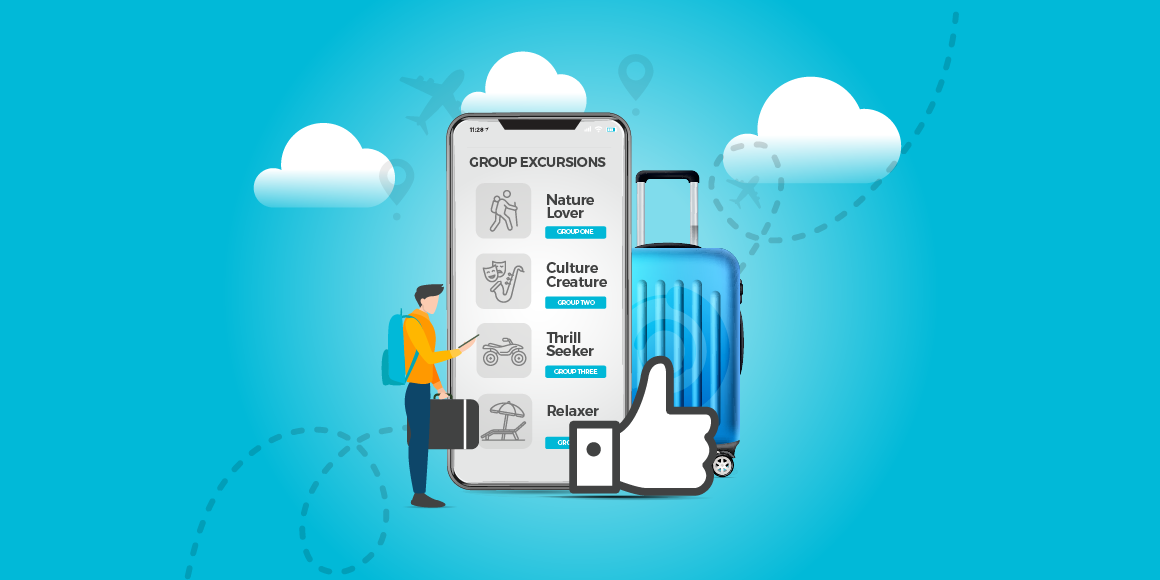Did you know the average incentive travel program boosts sales productivity by 18%?
Not only that, but they also produce an impressive average return on investment of 112%! According to SITE Global, incentive travel programs routinely meet sales and revenue goals. In fact, 96% of respondents believe they are effective at meeting program objectives.
But financial returns aren't the only indicator of success.
Successful incentive travel programs strengthen business relationships as much as the bottom line. We dug into the latest industry reports to help you uncover the top incentive travel trends. Read on to discover the top seven incentive travel trends you need to know for 2025.
1. Incentive travel remains strategically important to business success.
58% of buyers seek soft-power benefits that improve culture, engagement, and relationships. 40% of buyers seek hard-power benefits that focus on financial ROI. (2024 Incentive Travel Index)
One trend is clear, buyers want more from their incentive travel programs.
Incentive travel is no longer considered a perk. Many leaders view incentive travel as a strategic differentiator. As companies seek a competitive advantage, incentive travel will continue to play a prominent role.
In fact, over half (55%) of senior leadership now view incentive travel as “essential.”
According to statistics from the 2024 Incentive Travel Index:
- 81% use incentive travel to retain talented employees
- 62% believe incentive travel gives them a competitive edge in the hiring process
- 70% agree that incentive travel is a strategic motivator for Millennials and Generation Z
These statistics highlight the importance of incentive travel to strategically attract, retain, and continually motivate a talented workforce.
2. Incentive travel participants want new destinations that are closer to home.
70% of participants want new destinations. 40% of attendees want destinations closer to home. (2024 Incentive Travel Index)
Buyers are now juggling the preferences of a multi-generational workforce.
According to the World Economic Forum, five generations are working side-by-side for the first time ever. And the U.S. Department of Labor reports Millennials and Gen Z will make up 60% of the workforce by 2025. A rapidly changing workforce means incentive travel programs must adapt to meet generational needs.
Statistics from the Incentive Research Foundation concluded:
- Workers of all ages are most motivated by a trip to Hawaii
- Early and mid-career workers choose Western Europe or a flight to a domestic destination
- Late-career workers prefer domestic locations in driving distance in lieu of domestic flights (after Hawaii)
The 2024 Attendee Preferences for Incentive Travel echoes this sentiment.
Hawaii, Florida, and Las Vegas are considered top destinations for domestic trips while preferred international locations for leisure include Western Europe and Central America.
3. Incentive travel participants crave free time and cultural experiences.
Group cultural experiences, relationship building, and free time are top priorities for participants. (2024 Incentive Travel Index)
Downtime and connection are top priorities for attendees.
The 2024 Attendee Preferences for Incentive Travel report states that 85% of participants want more unstructured time and relaxation in their group travel trips. A close second is the opportunity to have unique experiences.
According to the 2024 Incentive Travel Index:
- 50% of participants crave unique cultural experiences
- 45% of participants want more relationship building activities
- 41% of participants desire more unstructured free time and relaxation
In fact, free time jumped up four spots from the following year, showing the biggest leap of any activity. Other important factors for attendees are luxury accommodations and bucket list experiences, spending money provided for extras to cover out-of-pocket expenses, and the ability to bring a guest.
These statistics show that participants want more out of their incentive travel experiences, just like buyers.
4. Cruises appeal to attendees and buyers alike.
Buyers cite multiple ports of call and budget as the main reasons they are favoring cruises. (2024 Incentive Travel Index)
Buyers and participants are open to cruises, but for different reasons
The 2024 Attendee Preferences for Incentive Travel report highlights an eagerness for cruises. A whopping 75% of participants agree cruises are desirable regardless of the destination. All-inclusive amenities are part of the appeal to participants. Over three-quarters (77%) of attendees agree that a cruise ship provides all the comforts of a luxury hotel.
According to the 2024 Incentive Travel Index:
- 30% of North American buyers are considering cruises as a new option for incentive travel trips
- River, Mediterranean, and Caribbean cruises are most popular with buyers
- Nearly one-quarter (24%) plan to decrease cruises to Alaska
Buyers cite multiple ports of call as the most favored reason for choosing river and Mediterranean cruises. Over half of buyers (53%) state budget-friendly options as a main driver for selecting cruises to the Caribbean.
Savvy incentive planners would be well-served to recognize the potential of cruises for their incentive travel trips in 2025.
5. Incentive travel programs get a little help from artificial intelligence.
Nearly two-thirds of respondents (63%) believe generative AI will be used (or is already being used) effectively within incentive travel. (2024 Incentive Travel Index)
Many in the incentive travel industry believe AI will play a substantial role in the future.
However, not all agree with this sentiment. According to the 2024 Incentive Travel Index, 8% of respondents believe AI has no future within incentive travel programs, citing incentive travel is too high touch, personalized, and too complex to be effective. Other concerns highlighted by this group include costs, risks, as well as legal and policy constraints.
The 2024 Incentive Travel Index states:
- 62% plan to use AI to prepare program materials
- 54% plan to use AI for planning, forecasting, and budgeting
- 45% plan to use AI for live communications with participants
While many see hope when it comes to AI, others in the industry see doubt. Only time will tell who is correct. One thing is sure though, if AI can be used effectively, those using it will have a leg up on their competition.
No matter where you stand on this digital divide, it’s a trend worth watching closely.
6. Incentive travel is ripe for a makeover to satisfy younger participants.
67% of incentives professionals agree younger generations will cause a powerful “retool” of incentive travel. (2024 Incentive Travel Index)
Millennials and Gen Z are changing the game for incentive travel in 2025.
According to the 2025 Incentive Travel Trends report, younger audiences may impact all aspects of incentive travel programming. So, what’s likely to change? Experts say you should expect edgier music, shorter keynotes, and more visually stunning Insta-worthy moments.
The Incentive Research Foundation’s Generational Expectations of Incentives report states:
- 25% of Millennials and Gen Z crave beach locations
- 21% of Millennials and Gen Z want elaborate food experiences
- 19% of Millennials and Gen Z desire sightseeing and learning experiences
- 18% of Millennials and Gen Z are drawn to fun activities (golfing, hiking, safari, etc.)
Younger generations desire more choice in their incentive travel trips. Planners are adapting to this need by offering increased flexibility for activities, agendas, and dining options. There’s also a stronger focus on wellness, well-being, and inclusivity. Incentive planners would be wise to keep these considerations in mind when planning trips in 2025.
7. Traditional incentive travel is alive and well in 2025.
Buyers increasingly view incentive travel as a reward for individuals and plan to use traditional qualification-based sales incentives in 2025. (2024 Incentive Travel Index)
Incentive experts are bullish about incentive travel projections in the coming years.
In fact, according to the 2024 Incentive Travel Index, 45% of buyers expect incentive travel activity to be above or significantly above 2024 levels by 2026. Additionally, 41% of buyers agree many rewards today are perceived as “deserved,” and therefore lack the motivation that incentive travel can bring. These statistics highlight a strong need for incentive travel as a reward in the coming years.
According to statistics from the 2024 Incentive Travel Index:
- 54% of buyers plan to use more tiers in their incentive programs
- 47% of buyers see incentive travel as a reward for individuals over broader benefits
- 45% of buyers plan to increase use of traditional, qualification-based sales incentives
The Incentive Research Foundation’s Generational Expectations of Incentives report echoes this sentiment. According to statistics from the report, early, mid, and late career workers all agree that individual travel is a highly motivating reward. It ranks second only to time off.
According to the report:
- 59% of early-stage workers 18-30 see individual travel as a highly motivational reward
- 60% of mid-stage workers 31-50 see individual travel as a highly motivational reward
- 58% of late-stage workers 51+ see individual travel as a highly motivational reward
These statistics appear to suggest that incentive travel has a bright future. The 2024 Incentive Travel Index also states that company-wide incentive travel trips plan to increase by 37% in 2025. All this is great news for the incentive travel industry.
Whether used as an individual or company-wide award, incentive travel is here to stay.
Are you ready to upgrade your incentive travel program?
The rules of incentive travel are changing.
No longer is incentive travel about honoring loyalty. It has shifted into a deeper, more strategic approach. Businesses looking to attract and retain workers will benefit from adding incentive travel programs.
Additionally, those looking to add or improve business relationships stand to gain.
Winning incentive strategies must offer new destinations that are close to home, provide all-inclusive accommodations, and offer unique experiences. Buyers must also structure programs that allow for flexibility to remain competitive. Attendees desire schedules that allow for downtime and opportunities to connect as a group on their own terms.
If you’re looking to add incentive travel to your mix of incentives, reach out today!






